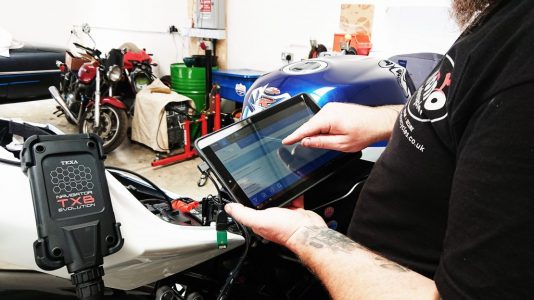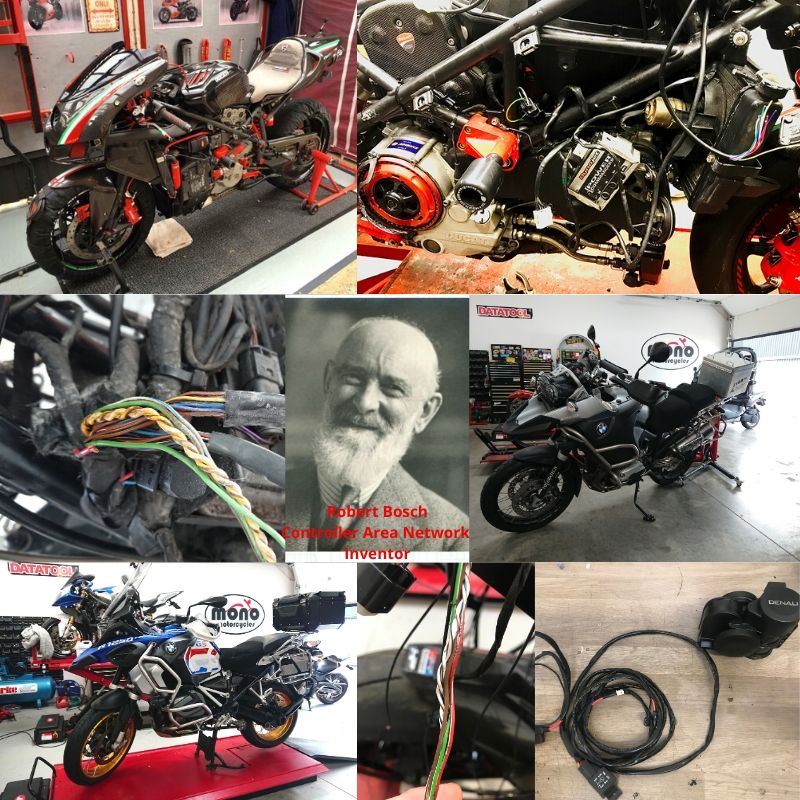CAN bus wiring networks. A guide by ‘wiring whisperer’ Daniel Morris.
“Motorcycle wiring, complicated? I am told daily it’s “a black art”, to be honest it’s getting a whole lot more complicated!

With motorcycles now having more gadgets than a family hatchback, consumer demand for cornering ABS, traction control, switchable maps, TFT screens & cruise control; manufactures are now using technology from cars & trucks on our motorcycles. CAN bus is one such crossover.
You may have heard of CAN bus, Especially if you own a BMW Or Ducati, but you will soon be seeing a whole lot more on all makes & models of motorcycles. In fact, one of the first motorcycles to run CAN bus was the Ducati 999 back in 2002. Although it was only used between the ECU, Immobiliser & Dash; the first motorcycle to run a full network, was BMW in 2004 with the GS range.

So, what is CAN bus & why is it so important on modem motorcycles?
CAN bus or to give it its proper name Controller Area Network, was invented by Robert Bosch in 1986 & first used in cars in in the 90s.
Bosch invented a network from a standard designed to allow microcontrollers & devices to communicate with each other in applications without a host computer.
This network is capable of sending various signals down one single wire, which has many advantages. First, it saves a huge amount of wiring & in turn this saves weight, space & above all for manufactures, cost with microprocessors being cheap to manufacture.
Another advantage is the network doesn’t need a fuse box as the ECU can detect a fault & switch that circuit off until the fault is repaired & the ignition is cycled.
The CAN bus network runs different priority codes for different components as multiple units can share the same single bus wire so ABS or Traction control needs to take priority over a signal for a light switch, not that you would know, as it all happens at 1mb per second.
All sounds great, yes?!
Well it’s good news for dealers with the software to diagnose the faults, at ,mono motorcycles we too have had to invest in the Texa Diagnostics to keep up with the latest technology.

But what does it mean for the home technician? To be honest there is no need to panic, just yet. CAN bus tends to be very reliable with the only issues we have seen at the mono motorcycles workshop being the odd snapped wire due to their small dimensions & switches becoming corroded.
The main issue with CAN bus, is it is more difficult to add hardware such as extra lights, Sat Nav’s & heated grips, etc
The reason for this is most CAN networks run very little voltage as the signal is a digital. Even where there are 12volts cutting into the harness or adding extra lights off the back of the original headlight; this will change the load over the length of the circuit, making the ECU think there is an issue, which will in turn switch that circuit off until it’s repaired.
Even repairing a section of damaged loom in Can bus, you need to take care. The wire needs to be the same gauge & length or again the ECU will shut the consumer down.
Quite often if you open up the CAN bus wiring loom, you may see that the wires are twisted around each other. This is designed to cut down on signal interference. These twisted wires tend to be data leads feeding huge amount of data back to a ecu. If these are damaged it’s extremely difficult to repair without upsetting the system.

Hardware can be added if you by pass the CAN network & wire direct to the battery with a separate loom. I recently added a Denali horn to a BMW GS. The Denali kit came with a loom, fuse & relay. This uses the original plug for the old horn to send a signal to the relay, so the BMW switch could still be used.

Like it or not, CAN bus is here to stay, we just need to keep abreast of the changing trends & fully embrace this new (ish) technology. “
Written by Daniel Morris – Master Motorcycle Technician & Motorcycle Wiring Specialist
If you have a wiring fault, or are looking for an entire wiring solution for your motorcycle; call Daniel Morris on T: 01243 576212 / 07899 654446 or contact him through our contact page.
